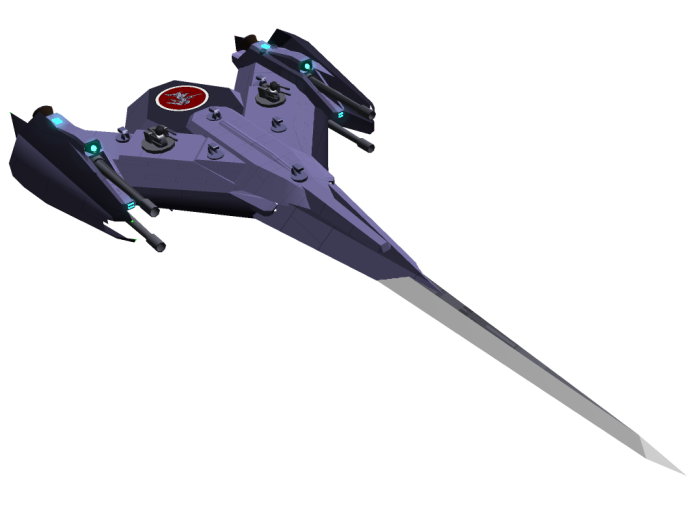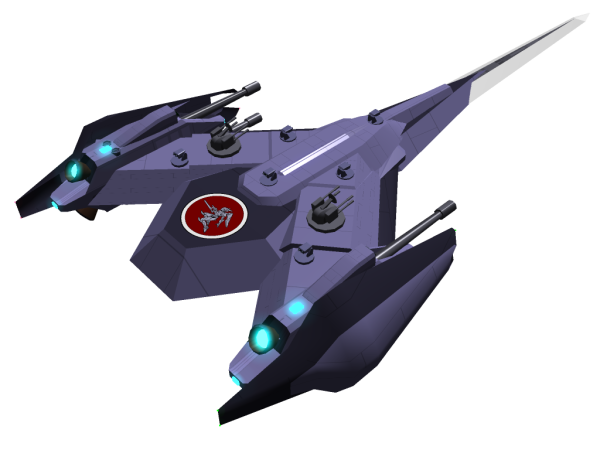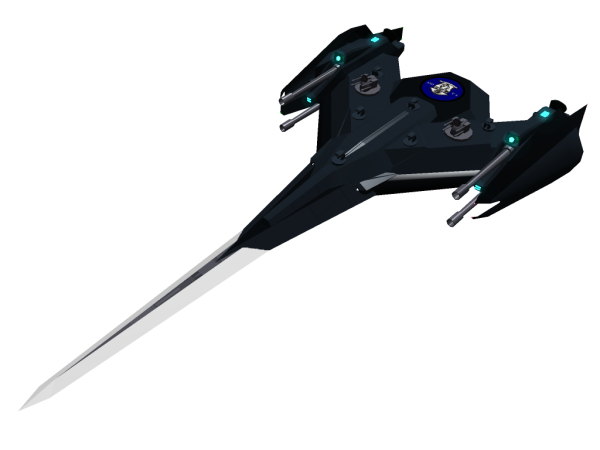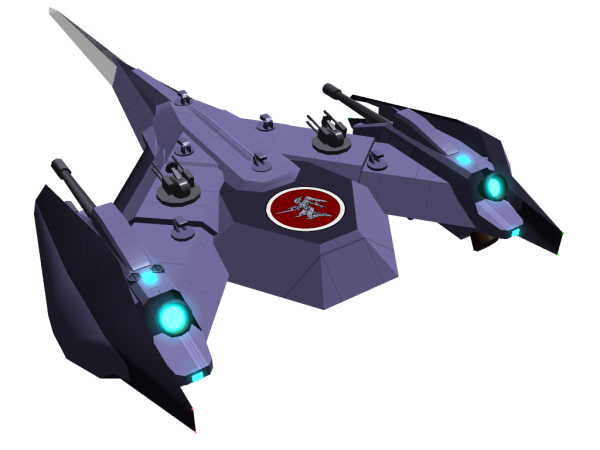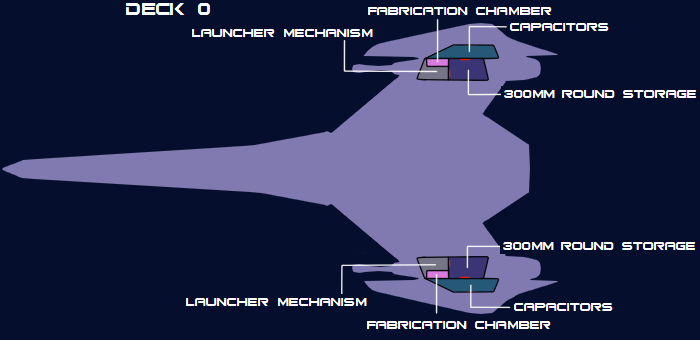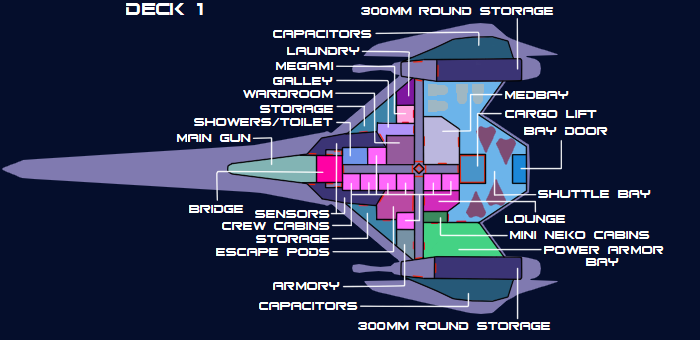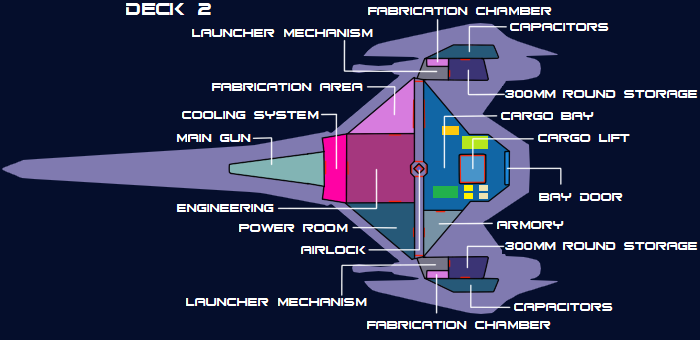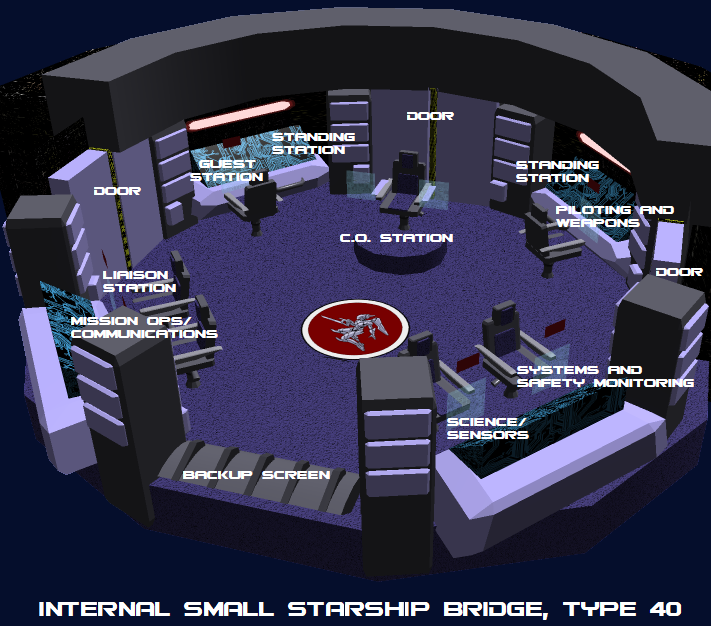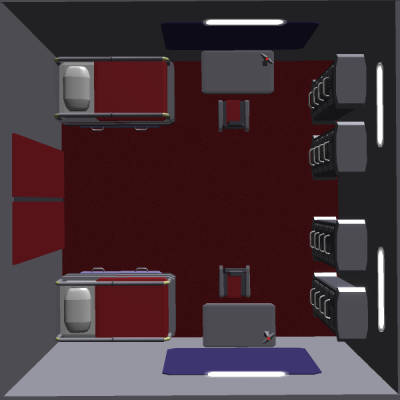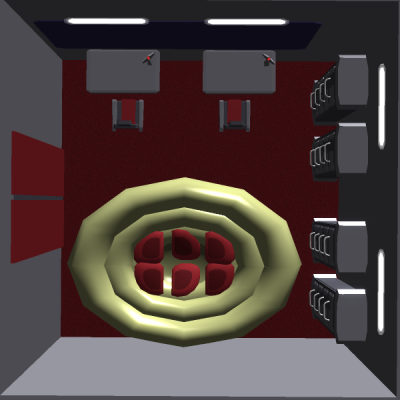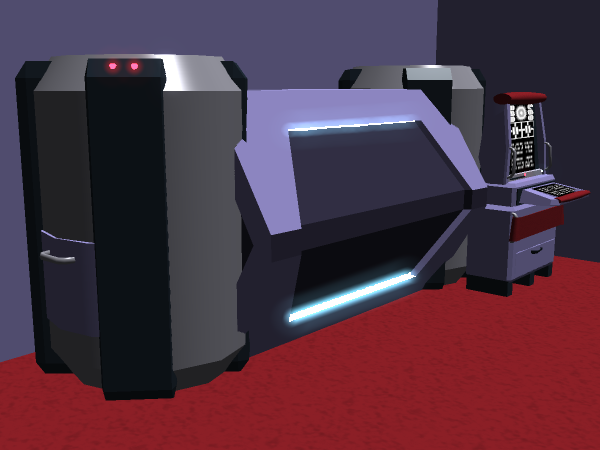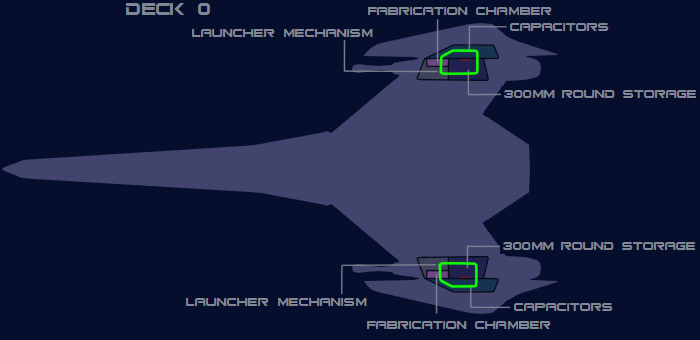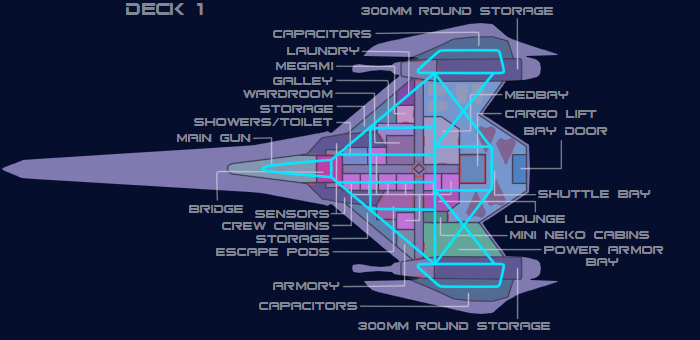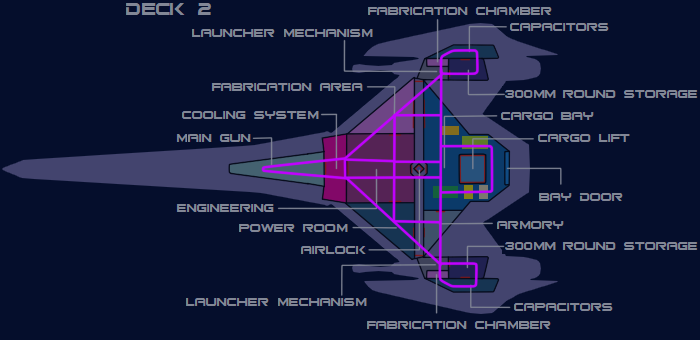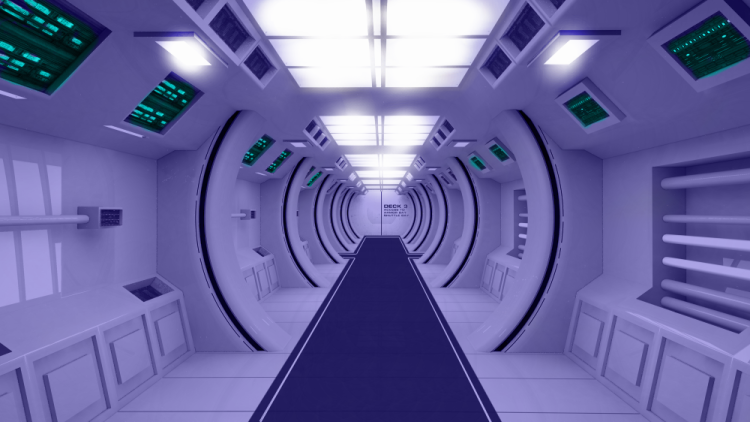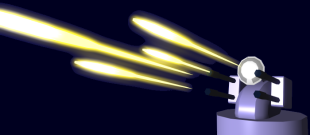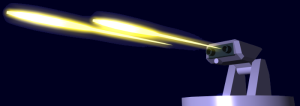Table of Contents
Azusa-class Light Gunship
The Azusa-class Light Gunship is a small gunship designed by Kage Yaichiro and first manufactured in YE 41 by Ketsurui Fleet Yards for service in the Star Army of Yamatai. It is built on the platform of the Chiaki-class (1B) Escort Destroyer, and intended to fill roles analogous to the Sakura-class Light Gunship. Using NH-33M (Miniature) pilots, it is also possible for the Azusa to employ infantry in numbers matching the Plumeria-class (2E) Medium Gunship using a smaller platform.
About the Azusa
The Azusa-class Light Gunship is notable for being a re-creation of the Sakura-class Light Gunship with modernized technology and existing parts, intending to fill the role of the original while also catering to new tactics and concepts. It was designed by Kage Yaichiro in YE 41 as an offshoot of the Chiaki-class (1B) Escort Destroyer and the Plumeria-class (2E) Medium Gunship, using the former's footprint and a few more of the latter's components. It sits between the two in production time and cost, though it sides far closer to the Chiaki 1B in this regard, allowing for a cost-effective Light Gunship at a fraction the cost of the jack-of-all-trades Plumeria 2E.
While the Azusa lacks the Plumeria's sheer versatility or point defense strength, it was not meant to blindly follow the Plumeria in role. The Azusa is intended to be a formidable gunship with a powerful and spread-capable main gun, high speed, and enough vehicle and infantry capacity to function in support of other operations – like the Sakura was. One of these roles, notably, is the defense of Yamataian star systems and the blockade of enemy star systems through the use of squadron-based Blink Tactics - a task which would otherwise fall to Plumeria that are better employed in other roles in the war. The Azusa is also intended to fill spaces within fleets that call for a gunship, but do not require the Plumeria's unique strengths.
In spite of not being as impressive as the Plumeria, the Azusa also serves a unique secondary role as a Light Carrier that can optionally employ a disproportionately large NH-33M (Miniature)-based infantry force once an appropriate armor for them is developed. In doing so, it can match the base Plumeria 2E's maximum possible infantry force.
Even with just normal pilots, however, the Azusa has a larger maximum crew compliment and fighting capacity than the Sakura had due to heavy optimization of space and the advancement of technology.
Namesake
The name Azusa comes from the name for the Yamataian Cherry Birch. It was chosen because though the S5 Project's Azusa is based on the D7 Project's Chiaki and is not directly related to the S3 Project's Sakura-class, it is quite similar and intended to perform the same role. As such, a plant that was not truly related to the Sakura (Cherry) tree but had many similarities was chosen to be the namesake for the ship.
The name was further cemented by the image of large numbers of Power Armor leaving the ship much like petals or leaves falling from a tree.
Key Features
- A single spread-capable Ke-S5-W4100 Aether Shock Array
- Four variable-speed 300mm guns capable of firing positron shells, electron shells, or solenoid projectiles
- Ample point defense coverage for its size
- Easy to repair and maintain due to comparatively simple construction and streamlined technology, some of which is modular like the Ke-D7-M3900 Chiaki Pylon Module or the panels of the Integrated CFS Array
- Low cost thanks to the commonality of parts with other Star Army vessels
- Angular hull of double-thickness for tank-like durability, even when using more common materials
Mission Specialization
- STL Superiority: Through the use of Blink Tactics, the Azusa is intended to operate in squadrons outside the edges of star systems where ships must travel at STL speeds for entrance or egress. By taking advantage of their stealth, their FTL capability, and their spread-capable main guns, these groups of Azusa can attack enemy vessels at this vulnerable stage with successive blasts to disable shields and destroy enemies without concern for friendlies or assets nearby. In this way, the Azusa can be used in sustained defense and blockade strategies.
- General Escort and Patrol: The Azusa is small, quick and carries large damage potential. Though it can still stay attached (sometimes literally as a parasitic escort) to capital ship groups or planets and use its high speed to intercept threats, it can now be used as an offensive or defensive vessel. It can serve in a wolf pack, as an interceptor-destroyer, or as a general patrol ship.
- Planetary Support/Defense: The Azusa can use its Mass Launchers as flying artillery in order to bombard enemy positions, as well as use the Electron Shells of the same weapon to overload enemy power infrastructure. It can also be fitted with different types of turrets to assist with anti-aerofighter/mecha situations. Due to this, it is useful in supporting Star Army Rikugun operations.
- Light Infantry Carrier: Capable of carrying up to 120 Power Armor if piloted by NH-33M (Miniature), the Azusa can act as a carrier for infantry forces far larger than its size would suggest once an appropriate Power Armor is developed.
Appearance
The vessel is clearly of the Chiaki lineage, with a secondary spike added from a Plumeria to result in a vessel that harkens back to both the Ketsueki-class Escort and the Sakura-class Light Gunship. The vessel is angular and has Ke-D7-M3900 Chiaki Pylon Modules and nacelles similar to the Plumeria with its armored shields on the outside. Its vital systems are stored in the center of the vessel, with the shuttle bay and the cargo bay in the half-hexagon-like shape attached to the back of the ship.
SAINT Livery
Star Army Intelligence uses a black-hulled version:
History and Background
During the merged refit project for the Plumeria-class (2E) Medium Gunship and the Chiaki-class (1B) Escort Destroyer, designer Kage Yaichiro noted the creation of the Fuji-class Expeditionary Gunship in YE 39 and perceived a general progression to larger and larger gunships to the point where they ceased to function as gunships and more as multipurpose cruisers. While the need for these larger vessels was clear, and the Plumeria had hit the 'sweet spot' of this niche, the S3-series of gunships was profoundly successful in war because they were small and maneuverable. This was something which might be lost if this trend continued.
While the Plumeria 2E Refit was able to reclaim this speed and maneuverability thanks to advances in engine technology and thrust vectoring, the purpose of this refit was generally to embrace the jack-of-all-trades role without compromising its gunship capability. However, the larger ship still took more time and resources to make than the old Sakura-class Light Gunship. With the Kuvexian War in full swing and a cheaper gunship needed on various fronts, it was time to revisit the historically successful Light Gunship project. This realization was made doubly important with the advent of Blink Tactics by Yaichiro in YE 40, which relied upon fast vessels with high output spread-capable main guns - in short, gunships. With the effectiveness of Blink Tactics proven, Yaichiro got to work on the S5 Light Gunship Project and he knew exactly what platform on which to build it.
The Chiaki 1B variant had a common parts pool with the Plumeria 2E to streamline production and repairs, very similar secondary armaments, similar crew capacity, and was even the proper size. With the Plumeria 2E's lower spike added to the Chiaki 1B as her new main gun, it even achieved the exact same length as the old Sakura. It also managed a higher STL speed without compromising on its defense, though Yaichiro had to employ slight compromises with its still notable FTL speeds compared to her inspiration.
The S5, by this time known as the Azusa-class Light Gunship, was designed to emulate the Sakura's most successful aspects in as many ways as possible while taking advantage of new combat doctrine and technologies, but a notable decision was made to notably enhance the ship's infantry capacity. The ship was designed to optionally employ NH-33M (Miniature) pilots and crew, which permitted a massive increase in the infantry capacity for the vessel should an appropriate power armor for them be developed in the future. This even matched it to the Plumeria 2E at its maximum capacity. While by no means a requirement to function with a notable infantry presence, mini-Neko support was included as an attractive option that did not compromise the vessel's performance as a gunship.
After the development of Blink Tactics and at roughly the time of the First Expeditionary Fleet's reconstruction, the S5 Azusa-class Light Gunship would be ready for mass production and deployment as a branching off of the S3 line intended to carry on the concept of the Light Gunship into the YE 40s.
Statistics and Performance
The Azusa is a fast ship with an optimized internal layout. She is notable for her firepower, her infantry capacity, her maximum complement, and vehicle carrying capacity; all disproportional to her size. She can also to operate in atmosphere and protect assets like planets and larger ships. The thrust vectoring capability of her engines also grants her impressive maneuverability.
General
- Class: Ke-S5-1A
- Type: Light Gunship/Carrier
- Designer: Kage Yaichiro
- Manufacturer: Ketsurui Fleet Yards
- Production: Mass Production
- Fielded by: Star Army of Yamatai
Passengers
- Crew: 6 operators are recommended, 2 are required (pilot/gunner and damage control/sensors/engineering).
- Maximum Capacity: There are accommodations for a maximum of 32 full-sized people with 4 beds per cabin, though it is more common to have 2 per cabin and the CO to have their own room for a typical maximum of 15. A sixteenth is present if counting the MEGAMI's avatar. The vessel can also support up to 160 NH-33M (Miniature), though this full compliment is unlikely. About 140 full-sized people can fit aboard in an emergency, but the ship would suffer reduced combat effectiveness.
Dimensions
- Length: 173.65 meters (569.72 feet), the same as a Sakura-class Light Gunship
- Width: 80.9 meters (265.42 feet)
- Height: 21.7 meters (71.19 feet)
- Decks: 2 full decks (5.3 to 6.3 meters each depending on location) plus small “Deck 0” in upper pylon modules
Propulsion and Range
- Integrated CFS Array/Continuum Distortion Drive: 18,750c (~2.14 light-years per hour)
- Maximum Speed of two Ride-Linked Chiaki: 21,915c (2.5 light-years per hour - This speed is a military secret.)
- Hyperspace Fold Drive: 394,470c (0.75 ly/m)
-
- Atmospheric Speed (Prop): 864 kilometers per hour (537 mph/Mach 0.7)
- Atmospheric Speed (Jet): 6174 kilometers per hour (3836 mph/Mach 5)
- Water Speed (Magnetic without Barriers): 200 kilometers per hour (108 knots)
- Water Speed (Magnetic with Barriers): 800 kilometers per hour (430 knots)
- Orbital Sublight Speed: 0.05c (~14,990 kilometers per second)
- Maximum Sublight Speed: 0.40c (~119,917 kilometers per second)
- Range: Though its range is indefinite, its effective range is 10 light-years based on its ability to independently respond quickly to events.
- Lifespan: About 30 years, can be expanded through refits.
- Refit Cycle: About once every five years.
Damage Capacity
See Damage Rating (Version 3) for an explanation of the damage system.
- Tier: 11, (Medium Starship)
Shields are Tier 12 for two Ride-Linked Azusa or an Azusa and a Chiaki.
Inside the Ship
The Azusa's interior is carefully planned and arranged, having complexity and redundancy greater than that of many other vessels of her size. This pales, however, compared to the Plumeria 2E Refit.
Deck Layout
Please note that the red lines in the images below are Zesuaium Blast Shutters.
| Deck | Compartments |
|---|---|
| 0 | 300mm Round Storage, Capacitors, Fabrication Chambers, Launcher Mechanisms |
| 1 | 300mm Round Storage, Armory, Bridge, Capacitors, Crew Cabins, Escape Pods, Galley, Laundry Room, Lounge, Main Gun, Medbay, MEGAMI, Mini-Neko Cabins, Power Armor Bay, Sensors, Showers/Toilet, Shuttle Bay, Storage, Wardroom |
| 2 | 300mm Round Storage, Airlock, Armory, Capacitors, Cargo Bay, Cooling System, Engineering, Fabrication Area, Fabrication Chambers, Launcher Mechanisms, Main Gun, Power Room |
Compartment Layouts
All listed areas have phones and firefighting stations. They also all have at least 33cm of bulkhead in place for walls and some are able to be sealed by Zesuaium Blast Shutters.
300mm Round Storage (6)
Located in the Ke-D7-M3900 Chiaki Pylon Modules on all decks, behind the Fabrication Chambers and Launcher Mechanisms, the modified magazines hold the 300mm Mass Launcher Rounds and are more efficiently placed than in the Plumeria. This is due to design differences allowing their location right behind the Launcher Mechanisms. While some of the space is allocated to loading mechanisms and various conduits and maintenance passageways, the craft still manages to hold the same 4800 rounds as the Plumeria-class Gunship utilizes.
Like the Plumeria, more could have been included but loading speed was considered as a superior concern past a certain point. It was also necessary to leave room for engineers to be able to freely access the engines to maintain them.
Airlock
The Azusa's airlock is standard, but with a couple twists. The airlock itself is under the center of the passageway in Deck 2. Blast shutters at the entryways to the main passageway will shut, the passageway will depressurize, then the door will open to space. The thickness of the deck at this location allows for a retractable umbilical to extend without compromising armor thickness. A storage locker is found on the aft side of the passageway on Deck 2, next to the entry into the Cargo Bay.
Armories (2)
Two Armories exist on the port side of the vessel and are commonly locked behind blast shutters. While both carry typical sidearms and weaponry for ship defense, the one on Deck 2 also holds vehicle weaponry and terrestrial equipment to support vehicles in the Cargo Bay. The Power Armor Bay on Deck 1 holds power armor and fighter weaponry, so the Armory on Deck 1 does not need to store special armaments. If the Cargo Bay is used for other purposes, such as supporting fighters or Power Armor, the armory on Deck 2 can be used for that equipment's weaponry instead.
Bridge
Matching the Plumeria, the Azusa uses a Star Army Internal Small Starship Bridge, Type 40. It is found on Deck 1, between the two white running lights/sensors at the fore of the ship. Though this type of bridge is typically reserved for placement deeper inside a vessel's hull than Deck 1, the large amounts of armor and structural support above the bridge allow it to have a comparable level of protection.
The Bridge also cannot be accessed except by those who have permission from the Commanding Officer and has three doors with blast shutters that can restrict access. The Bridge has 7 seated stations including that of the CO, 2 standing stations, and the ability to employ volumetric projections over almost every surface and space within. It can also use force fields to restrain or partially mitigate weapons damage from hostiles.
The side doors lead out into secondary exits, while the rear door accesses the Main Passageway.
Capacitors
Located in the armored nacelles on all decks, where storage space is found in the Chiaki 1B and CFS systems are found in the Chiaki 1A, are an array of capacitors which are charged by the Pylon Modules. These capacitors, while not strictly necessary in typical operation, are designed to assist in helping the vessel avoid power drops from extended combat due to the added strength of the main gun and the fold systems. They are also used as supplemental power sources should Engineering take damage.
Due to their location, energy capacity has been sacrificed for durability and safety to avoid being a weak point or a safety issue in combat. Additional Durandium and Yarvex lines this area to protect it from attack. While not impossible to detonate, it is far more difficult than, say, striking Main Engineering.
Cargo Bay
The Azusa's Cargo Bay, located on Deck 2 at the rear of the ship, is 34 meters wide at its widest point and 23 meters long with a loading gate 8 meters wide. It is 5 meters tall. It is shaped like half of a hexagon with a chunk removed for the Armory; the middle having a Cargo Lift. The Cargo Bay also connects to this Armory to serve combat forces. It is also common for the Cargo Bay to store repair equipment and parts for Power Armor made ahead of time in the Fabrication Area due to the sheer size of the ship's maximum capacity.
It has white padded walls, white and red interior lights, and a metal floor with plenty of tie-down points and strips of rollers. It also has power hookups so that power sources built into cargo containers can be slaved to the ship's power distribution system for backup power. The site also has a Cargo Lift that can lift anything up to and including SSCC-Mediums or a Ke-V6-2A "Hayabusa II" Starfighter between the Cargo Bay and the Shuttle Bay. This lift can move most vehicles as well. There is also a small ramp that can extend and allow vehicles to deploy from the Azusa's Cargo Bay if needed.
In addition to a Scalable Graviton Beam Projector Array, each end of the Cargo Bay has a large robotic arm that extends from the ceiling area for manipulating cargo or vehicles. It can be manually operated via a mobile control console, by SPINE interface, or (by placing the console on automatic mode) operated by the ship's computer via voice command.
Capacity
The bay can hold assorted configurations of craft dependent on mission profile and the preferences of the commanding officer. It is most common to hold:
- 4 of some combination of Type 30 Light Utility Truck and Type 30 Tankette
- 1 Type 30 Surface Terrain Vehicle or variant
- 2 K-1 Bulldog/Type 41 Main Battle Tank or variant
Crew Cabins (8)
Seven Large Crew Cabins line the port side of Deck 1's main passageway, with one more near the armory in the perpendicular corridor. All measure 5m x 5m x 2m. The forward-most one is reserved for the Commanding Officer and other officers in the vessel if sharing the room is necessary. It has a hidden second door behind a volumetric window leading to a small passageway that leads to the Bridge.
The rooms can employ Star Army Bunk Bed, Type 40 or the Star Army Nekovalkyrja Nest/Life Raft, Type 40 to house anywhere from 1 to 6 people, though 2 and 4 person configurations are the most common to sleep a total of 15 (if the CO sleeps alone) or 32 crew. It is not uncommon to fold up a bunk bed and a desk to stow them along a wall if the room is occupied by only a single person. Each room also has four lockers along the back and two desks, as well as Volumetric Windows which also provide the room's lighting.
Escape Pods (9)
On Deck 1, just port of the Crew Cabins, are eight Star Army Escape Pod, Type 35 "Seizonsha"s. These launch vertically and can hold a combined 40 people normally or 56 people in a case of emergency. It should be noted that in addition to launching Escape Pods, these areas also launch hundreds of inflatable 'dummy' pods which are designed to overwhelm an enemy with targets which fly out in all directions while also providing false sensor readings. These dummy pods appear both in Escape Pod and SS Pod variants. The ship's Type 31 Electronic Warfare Suite may be able to achieve the same effect, but the dummy pods persist if the vessel has been disabled or destroyed and can persist beyond the suite's range limits.
One Star Army Escape Pod, Type 41 "Kodate" can launch from the Mini-Neko Cabins, also serving as their living quarters in daily operation. It typically houses 80 Mini-Neko or less and one full-sized person (or Mini-Neko in Power Armor), though it can cater to up to 160 Mini-Neko and 3 full-sized people if needed.
Soul Savior Pod (1)
Stored and launched from the Escape Pod area, the ship's Soul Savior Pod can be launched by itself or while inside a Star Army Escape Pod, Type 35 "Seizonsha" if that is the preference of the CO. While the use of an Escape Pod for this task risks easier detection by an enemy, it does allow the Soul Savior Pod to be transported at faster-than-light speed away from the vessel if launched while in interstellar space.
Engineering
Engineering is in the front half of Deck 2. It combines several functions by having several sections cordoned off with Transparent Durandium, including the Fabrication Area (inside one deck). These sections have transparent durandium bases, too, so they appear to “float” over the machinery and cables along the “floor” and ceiling. It also has access to several larger Standard Star Army Maintenance Conduits.
Fabrication Area
Compressed to one deck and located on the fore-starboard part of the ship, the Fabrication Area has been optimized and improved in part because of the higher-than-typical deck height. One noteworthy change is that it has a large door through which vehicles can be moved across the Passageway to the Cargo Bay across from it. In this manner ground vehicles, cargo, or even vehicles from the Shuttle Bay (via the Cargo Lift) can be moved to or from these areas while fully assembled. It should be noted that the Fabrication Area is often used proactively to produce spare parts and equipment for the ship's Power Armor, which are then stored in storage and/or the Cargo Bay, due to the sheer disparity between the ship's size and the maximum magnitude of its infantry forces.
The nodal fabrication times are the same as Yuuko, but without the capability to build weapon pods or torpedoes.
Power Room
The Power Room in the fore-port part of the ship works to provide power for the main gun, the fold system, and other components. The Aether Generator close to Engineering is the primary draw here, though it also has an array of large capacitors and fusion reactors for backup power.
Fabrication Chambers (4)
Located in the Ke-D7-M3900 Chiaki Pylon Modules on Decks 0 and 2, these Star Army Fabrication Chambers, Type 39 are used to construct 300mm Mass Launcher Rounds for the nearby Ke-D7-W3900 Mass Launchers and assorted Power Armor and components. They differ from the Fabrication Area in that they can also work with organic matter and can help make food and rations for the crew if necessary to supplement the Galley. Each of the 4 chambers can feed 30 people regular meals, for a total of 120. Any more people would strain the system, requiring the creation of simplified rations instead. Of course, NH-33M (Miniature) can easily be fed en masse by this system.
Galley
Located in Deck 1 off the Wardroom, the Galley has been expanded into its own area with a built-in Scullery. It is also better stocked with spices and other such options to cater to a wider palette to improve morale. It also includes a multi-layer hydroponics system used to grow spinach, tomatoes, basil, and other herbs and vegetables. This helps the ship maintain a supply of quality ingredients when away from ports, much like that employed on the Plumeria-class.
It also has specialized equipment to prepare food for NH-33M (Miniature), though this isn't strictly necessary, and a blast shutter door leading to the MEGAMI computer core so that her avatar might function as the ship's cook if desired.
Launcher Mechanisms (4)
On Decks 0 and 2, specificly in the Ke-D7-M3900 Chiaki Pylon Modules, mechanisms for the Ke-D7-W3900 Mass Launchers can be found. The purpose of these is to fire 300mm Mass Launcher Rounds. Each is located next to a Star Army Fabrication Chamber, Type 39, and is also fed by the 300mm Round Storage in the Pylon Modules.
Laundry Room
The laundry room is on the starboard side of Deck 1, near the Pylon Module. It is compact and features five stackable washer/dryer units. There are also several tables that are bolted to the walls for folding laundry, and a single bolted-down couch for those waiting for their laundry to finish washing or drying.
Lounge
The Azusa has a small Lounge on Deck 1, though it is in a different location and size than that on the Chiaki. It is meant to be a place where, alongside the Wardroom, people can socialize and mingle. It is home to the traditional Dare Lottery Party.
It has Volumetric Windows for the walls and ceiling which can change color (typically red) and a floor that is thickly carpeted in a shaggy red carpet with the design of the Star Army Hinomaru in the center. The Lounge also has bolted-down furniture like a pair of soft leather couches and a couple of coffee tables. Lamps on some of the tables and in a circle around the ceiling provide soft, white lighting, focusing on the open area with the Hinomaru in the carpet. A small nook located off to the rear of the Lounge contains a Coffee maker, icemaker, microwave, mini-fridge, and a small drink bar. Note that the Lounges are not dining areas. The mini-fridge is used for drinks and small snacks only.
The port side of the Lounge is notable for having a section for NH-33M (Miniature) with their own to-scale furniture that connects to their own living area. Mini Neko can seat themselves comfortably and talk with their full-sized comrades here.
Main Gun Assembly
The Main Gun's assorted systems span the front of the ship through both Decks 1 and 2, but are most accessible from the Cooling System on Deck 2. Connections between the Engines, Engineering, Main Gun Power/Control, the capacitors in the nacelles, and the Main Gun itself are conducted through various interfaces and buffers in the Maintenance Conduits running through it accessible from Engineering.
At this place is a large warning notice cautioning about the dangers of vaporization. A round gray manual shutoff switch with a hand-sized rubberized grip bar across it is to the right of this sign, with a small panel that reads DISABLED in green or ENABLED in red. Below, a notice declares, “By order of the Star Army, the maintenance conduit beyond this point must be visually inspected to ensure there are no crew members present before the main cannon system is re-enabled. Failure to do so could result in death. Never turn this switch if the main cannon is not fully assembled.”
This is especially important due to the likelihood of NH-33M (Miniature) serving aboard the ship.
Cooling System
The Cooling System is an addition which is explicitly designed to help cool the larger main gun between shots. It is built into the base of the main gun's 'spike', where structural integrity is also bolstered. It is this cooling system which allows the weapon to have the refiring rate it does, and it can also serve to help give supplemental cooling to assorted Engineering components if needed.
Maintenance Conduits
The Azusa has Standard Star Army Maintenance Conduits that run throughout the ship, ribbed with support framing and lined with pipes and wiring. These allow access to some of the ship's more remote areas. They have minimal gravity and are usually quite loud inside. The complex nature of the starship means technicians will have to visit these conduits every so often to keep the ship in top working order, especially after intense battles.
Medbay
The Azusa's Medbay is located on Deck 1 ahead of the Shuttle Bay for easy access for returning wounded. It is a full-sized Sakura-type Medical Laboratory, but has beds which are able to function as an Autonomous Medical Treatment Center with no assisting nurse beyond other crew if necessary. The Azusa can thus provide more comprehensive medical aid to wounded allies if their own vessels are overloaded, or actively go out into a battlefield after a fight's conclusion to seek out stranded soldiers. It has all AMTC Standard Units, and supplies are kept inside a small cabinet inside the center.
It should be noted that this Medbay has added functionality to tend to NH-33M (Miniature), including a wall lined with rooms, equipment, and beds scaled to the mini-Neko.
MEGAMI
Located between the Laundry Room and Galley on the starboard side of Deck 1, the computer room containing the MEGAMI can be found. When compared to the Chiaki's CIES, it has been upgraded and has been moved from Engineering to make room for other systems as well as to allow the Avatar to better interact with the crew. It is not unusual for the MEGAMI's avatar to pull double-duty as the ship's cook, sometimes without the crew even realizing who they are interacting with. The MEGAMI's computer core has a number of cooling systems and consoles in the room, as well as cabling connecting assorted other high-end components and blast shutters to limit access to unauthorized personnel. In the center of the room is a Type 32 Pilot Pod which typically holds the MEGAMI's avatar. If needed, a person can also directly interface with the MEGAMI and/or the ship via this pod.
Mini-Neko Cabins
The Mini-Neko Cabins are a room of the ship where a Star Army Escape Pod, Type 41 "Kodate" is installed to allow NH-33M (Miniature) to live and interact. This escape pod can also carry a single full-sized person or a power armor-clad Mini-Neko if required to assist the mini-Neko in whatever environment they find themselves escaping to.
While seeming an oddity, these cabins allow a large infantry pilot force to live and function in a very small space roughly 1/10th the scale (1/1000th the volume) needed for a comparably sized force made of normal-sized pilots.
The other half of the room that is not oriented for housing the escape pod has two full-size chairs and some Mini-Neko furniture for meeting with full-size visitors.
Passageways
The passageways are all standard. Each passageway of the ship also has a Standard Damage Control Station. Eating or drinking in the passageways is forbidden.
Main Passageway
The main vertical passageway, in the center of the ship, is a Standard Star Army Zero-Gravity Passageway.
Power Armor Bay
Located port of the Shuttle Bay, the Power Armor Bay serves as both the storage facility for Power Armor and for weaponry. It has a massive Power Armor capacity for the size of the ship due to the vessel's use of NH-33M (Miniature), making the vessel functionally a carrier when used to its full potential. It has five double-sided racks which can be pushed together, rotated, and pushed against the ceiling to save space for storage when not in use. These racks store 10 rows of 12 normal Power Armor on each side, or 10 rows of 9 larger Power Armor/Light Mecha on each side.
A pair of secondary hatches can be used for entrance and egress from the Power Armor Bay, with the appropriate guiding lights and atmosphere containment force fields, though the pilots are more likely to go through the Shuttle Bay if possible.
Capacity
The bay has five double-sided racks for a maximum of 120 suits of power armor (Typically Mindy 2 or sometimes Daisy M6), or 90 larger variants (Kirie or Keiko). It also holds the weapons for the Power Armor as well as serving as storage for fighter weaponry.
Sensors (2)
The Sensors are located behind the running lights of the vessel on either side of the bridge. They are based on the Plumeria 2E's Rear Sensor Array. This is, in turn, based on the larger Sensor Pod in the same vessel. They expand the sensory capabilities of the Azusa while still protecting them with armor save for the areas typically exposed as running lights.
Showers/Toilet
Just behind the Bridge on Deck 1, the shower room doubles as a head. The ten commodes are sectioned off by doors on the starboard side, and the shower room is communal. The six sinks are found on the fore wall. A triple-wide mirror is in front of them.
Shuttle Bay
The Azusa's Shuttle Bay, located on Deck 1 at the rear of the ship, is a roughly two-chamber area with a loading gate 8 meters wide. It is 36 meters wide at its widest point and 5 meters tall. It also has a Cargo Lift. The Shuttle Bay also connects to the Medbay and a Power Armor Bay to serve combat forces.
It has white padded walls, white and red interior lights, and a metal floor with plenty of tie-down points and strips of rollers. It also has power hookups so that power sources built into cargo containers can be slaved to the ship's power distribution system for backup power. The site also has a Cargo Lift that can lift anything up to and including SSCC-Mediums or a Ke-V6-2A "Hayabusa II" Starfighter, as well as assorted vehicles. It should be noted that the room has force fields to prevent decompression and graviton beam projectors to allow the movement and manipulation of craft if needed.
Capacity
The bay can hold assorted configurations of craft dependent on mission profile and the preferences of the commanding officer. It is possible to carry and use a Raccoon T7, but this is less often employed due to the low crew compliment. It is most common to hold:
- 4 Kuma T8 shuttles
Storage
On the leading edges of the ship on Deck 1, next to the sensors, there are storage areas which can be used for assorted purposes. Often, they are used to store consumables, Power Armor parts, and other repair supplies. The Azusa has notably less storage space than the Chiaki, though this is in part because the Chiaki had more unconventional shapes in its internal construction which were not entirely fit for other purposes.
Of course, the vessel's Cargo Bay is still more than sufficient to carry Cargo that the Azusa may require.
Wardroom
The Azusa's wardroom is in the starboard/middle of the vessel, just opposite most of the Crew Cabins on Deck 1. It is a somewhat basic offering, but it is suitable and is served by a separate Galley/Scullery. It is also able to accomodate NH-33M (Miniature), and allows for mixed eating or for the mini Neko to sit in a “large” to-scale representation of their own wardroom that runs along one wall.
Ship Systems
In addition to the areas which are accessible in compartments, the ship has a number of other features and capabilities which are noteworthy.
Armored Hull
The primary substance used on the Azusa's meter-thick hull and in its frame is Yama-Dura. It is used to armor the fuselage of the ship and is backed by Integrated CFS Array paneling. Since it is weaker than Yamataium, the armor was designed to employ two 0.5-meter-thick armor plates for 1 meter of hull thickness rather than the typical 0.5-meter hull found on the Plumeria-class to compensate. It should be noted, however, that the Azusa has a very angular and tank-like hull which often results in a protective effect of the armor well beyond its 1 meter rating. The hull also has the Xiulurium stealth coating.
The Pylon Modules are made of more standard Yamataium with a Zesuaium frame and Xiulurium coating due to being drop-in Plumeria-compatible hardware, though this isn't enough added weight to impact the vessel's maximum speed. All interior passageways and rooms are surrounded by Yarvex sheeting and protected from scalar fields by the internal gravity systems. There is extra armor in the nacelle shields, especially to protect the capacitors next to the Pylon Modules that supplement the main power system.
The Azusa has no windows, but Volumetric Windows are employed to simulate them without any openings in the hull. Due to the nature of armor plate and Integrated CFS Array panel replacement, it is possible to replace the Yama-Dura armor with more durable Yamataium at the cost of changing the ship's top speed. This modification, however, is non-standard.
Graviton Beam Projector Array
Two Scalable Graviton Beam Projectors are mounted on the Azusa's nose and aft; in addition to various ones on the dorsal, ventral, fore, and aft of the Pylon Modules. This forms a Scalable Graviton Beam Projector Array. The array is used to project a stream of gravitons towards any object that requires fine manipulation, to direct weapons fire from the Mass Launchers, and even for hovering in gravity. They are ineffective against gravitic shielding.
Integrated Combined Field System Array
The Azusa has a Integrated CFS Array which is designed to mask the ship's movement and minimize the ship's effect on surrounding space. A “silent running” mode is also available, similar to the one first used on the Yuuko-class Gunboat. The ICFS also has assorted other benefits related to FTL speed modulation, fine shield geometry and strength control, ease of repair and replacement, and a level of decentralization that makes it a lot harder to disable than a conventional CFS.
MEGAMI
The Azusa uses a MEGAMI, in an upgrade over the Chiaki's computer system. It also includes an array of Psionic Signal Controllers and a Type 31 Electronic Warfare Suite, a.k.a. “Active Jamming System”, along with all the other sensors appropriate for a MEGAMI-equipped vessel. These systems are necessary for the ship's intended role participating in Blink Tactics.
Joint Stealth System
The Azusa features the Yuuko-class gunboat's Joint Stealth System and the Type 31 Electronic Warfare Suite (working as an updated Moua Active Jammer). Of course, the former has been upgraded to work with the new Integrated CFS Array.
Electron Countermeasures
It should be noted that the ICFS can also project electrons either in a dispersed form outside its barrier or as part of its barrier, to emulate the one aspect of Electron Countermeasure that the vessel's Ke-D7-W3900 Mass Launcher can't already perform. The Mass Launchers can already launch electron rounds into enemy positron munitions, allowing for full functionality of this mode without any need for dedicated hardware.
Emergency Systems
The Azusa contains all Star Army Standard Starship Emergency Systems, has an array of Psionic Signal Controllers, a standard Hemosynthetic Conduit System, and a limited Nodal System.
Damage Control Stations
On the Azusa, damage control stations are located in:
- Armory (4, 2 in each)
- Bridge (2)
- Capacitors (12, 2 in each area)
- Cargo Bay (4)
- Cooling System (2)
- Main Gun (4, 2 per deck)
- MEGAMI (2)
- Engineering (4)
- Fabrication Area (3)
- Launcher Mechanisms (4, 2 in each)
- Medbay (2)
- Power Armor Bay (2)
- Power Room (3)
- Sensor Compartments (4, 2 in each)
- Shuttle Bay (4)
Blast Shutters
Shutters are located in various locations throughout the ship and are indicated by red lines on the ship's deck plans.
Escape Pods and Soul Savior Pod
See the earlier references to the ship's Escape Pods regarding the ship's eight Star Army Escape Pod, Type 35 "Seizonsha"s, its Star Army Escape Pod, Type 41 "Kodate", and its Soul Savior Pod.
Life Support Systems
Atmospheric systems are divided into nine separate habitat zones: Front of Deck 1, Rear of Deck 1, Front of Deck 2, Rear of Deck 2, Bridge, the two Armories, and both Pylon Modules/Nacelles. The air recycling system, which is highly monitored for security reasons, can support up to 100 normal-sized personnel for up to five years (or 200 personnel for a brief period) and is designed to prevent the spread of contaminants and insects. After the start of the Second Mishhuvurthyar War, gunships were equipped with various anti-infestation countermeasures such as ultra-sonic beam emitters inside the ventilation tubes.
Waste is broken into its atomic components; useful elements are stored for later use in the fabrication area. Water can be recycled for twenty years and is stored in fairly large quantities for use in firefighting. The Azusa has the ability to land in a body of water and refill the ship's tanks with pure water in about five minutes through pumps, filters, and osmosis mechanisms.
Azusa are equipped with Psionic Signal Controllers.
The life support system takes relatively little power to operate; attempting to route power from life support to other, more powerful systems like shields is not an effective tactic.
Ride Link System
The Ride Link System is employed in cases where the Azusa is using its Scalable Graviton Beam Projector Array and the ventral Airlock to physically connect and cling to the hull of another vessel, or even belly-to-belly with another Azusa or Chiaki. It was inspired by the Himiko-class Light Escort.
By physically connecting to the vessel and allowing the two vetted and willing computer systems to interface, the ships can use their ICFS or CFS together to assist in the maintenance of the ship's shielding and propulsion. The weapons can also coordinate, allowing the Azusa's weapons and turrets to function slaved to that of the main ship. This is only enabled when both ships' staff explicitly allow the system to be enabled, to avoid hacking attempts. This can work with many large vessels with enough space on their hull for general concealment of numbers, but the system was designed with the Kagai-Class Assault Ship in mind for another reason; it can carry two Azusa or Chiaki on its underside to support a Star Army Century or other Star Army Rikugun assets en-route to and at a planet with its atmospheric and space combat capabilities.
While this system is normally used to bolster the defenses of vessels the ship is docked to rather than be dead weight while in transit, an interesting situation arises when a permutation of two Azusa or Chiaki dock together belly-to-belly. Not only can they coordinate each other's weapons, but they can use their shield emitters at 200 percent to each manage half of a merged barrier – resulting in one Tier of shielding above the typical capability for a lone Azusa. Top CFS-based FTL speed also increases to 21,915c, though this is a military secret.
Phasing Defense System
Inspired by the equivalent system on the Fuji-class Expeditionary Gunship, the Phasing Defense System is an additional system which is included not only in the hull of the vessel but also in the bulkheads, floors, and ceilings. It is based on one of the many fields normally integrated into the CFS or ICFS Array that already combats phasing but is additional and isolated so that phasing is not possible even when the ICFS is deactivated or disabled. It is typically always on and does not project beyond the hull of the vessel. It does not compromise the stealth capability of the ship.
Power Systems
The Azusa's main power source is a high-output aether generator; it also includes fusion reactors in Engineering and other aether generators in the Pylon Modules. Antimatter can also be used in the second stage of any Aether Reactor if proper care is taken. Capacitors also exist next to the Pylon Modules to hold energy to supplement the power system and are heavily armored by the nacelle shields and bulkheads underneath. Alternate generators and fuel tanks can be hooked up in the Cargo Bay if needed. The Azusa boasts an extremely robust power distribution system that is built to withstand and control tremendous surges (such as those caused by electrogravitic and electromagnetic pulses and anti-matter ion weaponry), based on and using parts from the Plumeria Gunship. The aether generators' second stages have their own independent backup power supply to maintain containment. In the event of an emergency, the aether or anti-matter can be safely vented automatically or manually.
Propulsion
The Azusa features three main methods of propulsion: it carries auxiliary thrust-vectoring Multi-Stage Aether Drives in its Pylons for planet-side and slower-than-light travel, it can use its combined field to travel at slower-than-light and faster-than-light speeds, and it can employ its Hyperspace Fold System for even longer range travel. It also features a basic anti-gravity system for hovering which can be supplemented by its Scalable Graviton Beam Projector Array or by using a mode of its Multi-Stage Aether Drive with thrust vectoring. It is possible to use the variable geometry of the shields to maximize the top speed of the vessel in a given medium when planet-side.
Anti-Gravity
For takeoff and landings on planets, the ship has a basic anti-gravity system on its underside that allows the ship to be lifted off planets of up to 10 times standard planetary gravity. The system allows for smooth vertical takeoffs and landings. In addition to this, it has a Scalable Graviton Beam Projector Array that allows for fine control and towing of vehicles as well as acting as a backup system to the normal anti-gravity system.
This system is also used to cling to the hulls of allied ships, permitting them to travel with allied vessels using their propulsion systems or employing the Ride Link system.
Auxiliary Engines
Though considered Auxiliary Engines, the Multi-Stage Aether Drives in the Pylon Modules are used regularly when in a combat situation due to the need to use the Integrated CFS Array for shielding. These are capable of thrust factoring their output with a series of force fields and can function in space, air, and even in water.
These engines can move the ship up to speeds of 0.40c.
Combined Field
The ICFS Array is the ship's primary method of travel and shielding.
See: Integrated CFS Array, Continuum Distortion Drive, and Combined Field System
Hyperspace Fold
Hyperspace Travel is used for long-distance movement; the fold system can reposition the ship to a new location in space. The time elapsed in real space will equal four minutes for every three light-years the Azusa is from its original position. The Fold System takes approximately one minute to charge and is located in Engineering, though this speed can be reduced to 30 seconds if the cooling system and the main gun charging circuit is employed. The systems that charge the fold system can assist in the charging of the main gun and vice-versa as well, in the case of damage.
Weapons Systems
The standard Azusa-class carries assorted weapons and is compliant with the Weapon Limitations. It also carries 4800 300mm Mass Launcher Rounds, and the ability to produce more.
- 1 Tier 13 (Light Anti-Capital Ship) Ke-S5-W4100 Aether Shock Array a.k.a. “Main Weapon Array” (4 OTW-equivalent)
- 4 typically Tier 11 (Medium Anti-Starship) Ke-D7-W3900 Mass Launchers (2 per Ke-D7-M3900 Chiaki Pylon Module) (4 OTWs)
- 4 Tier 9 (Heavy Anti-Mecha) Ke-S3-W3102 Star Army Anti-Fighter Turret, Type 31s a.k.a. “Heavy Quad Anti-Mecha Cannons” (1 TEWG)
- 12 Tier 5 (Medium Anti-Armor) Type 32 Medium Anti-Armor Turrets a.k.a. Heavy Dual Anti-Starship Gun Turrets (3/16 TEWG)
- 4 torpedoes on under-body hard points (typically Ke-Z1 Series Anti-Starship Torpedoes)
- 1 Scalable Graviton Beam Projector Array across entire vessel
Equipment Complement
The vessel's Cargo Bay and Shuttle Bay can carry a wide array of equipment and cargo for the vessel's size. Though the compliment can be adjusted or increased, the typical compliment includes:
Fighters
Power Armor
Shuttles
- 4 Kuma T8 shuttles
Vehicles
- 4 of some combination of Type 30 Light Utility Truck and Type 30 Tankette
- 1 Type 30 Surface Terrain Vehicle or variant
- 2 of some combination of K-1 Bulldog/Type 41 Main Battle Tank or variant
Miscellaneous
OOC Notes
Toshiro created this article on 2019/04/06 23:07.
Approved by Syaoran on 4/24/2019
A correction to the Tiers of its weapon systems was approved here on 1/19/21 by Wes. The vessel is still Weapon Limitations compliant.
| Products & Items Database | |
|---|---|
| Product Categories | starships |
| Product Name | Azusa-class Light Gunship |
| Nomenclature | Ke-S5-1A |
| Manufacturer | Ketsurui Fleet Yards |
